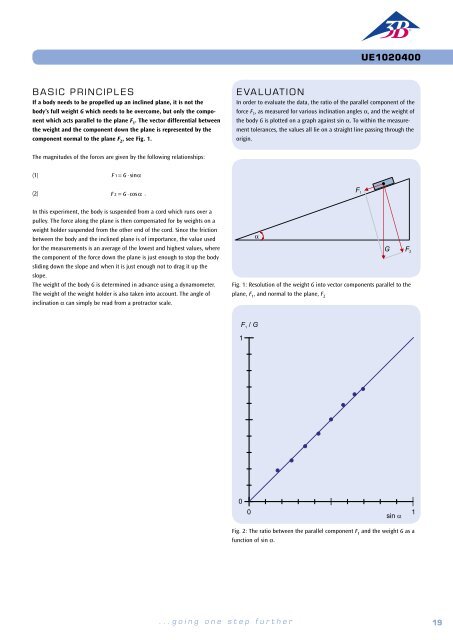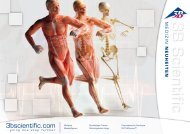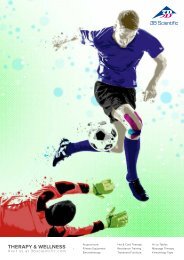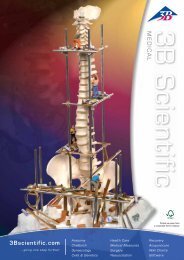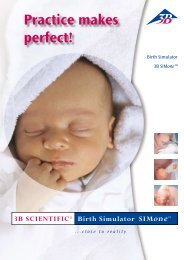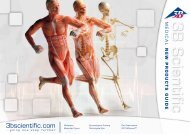3B Scientific - Physics & Engineering Experiments
3B Scientific - Physics & Engineering Experiments
3B Scientific - Physics & Engineering Experiments
Create successful ePaper yourself
Turn your PDF publications into a flip-book with our unique Google optimized e-Paper software.
UE1020500<br />
Mechanics / Forces<br />
Static and Dynamic Friction<br />
UE1020500<br />
BASIC PRINCIPLES<br />
In order to move an object from rest along a level surface, a force of<br />
inertia needs to be overcome. This results from static friction between<br />
the body and the surface on which it rests. If, once moving the body is<br />
to continue sliding along the surface, a force of F Dyn<br />
needs to be applied<br />
to overcome the dynamic friction. This force is smaller than the initial<br />
force needed to overcome the inertia caused by static friction F Stat<br />
, as<br />
the degree of contact between the sliding body and the surface beneath<br />
is less.<br />
Neither of these forces are dependent on the area in contact, instead being<br />
determined primarily by the types of materials and the roughness of the<br />
surfaces in contact. They are also proportional to the force that is pushing<br />
the surfaces together in a plane perpendicular to that of the surfaces themselves.<br />
This is called the normal force F N<br />
(it acts normally, i.e. perpendicular<br />
to the surface). The coefficients of static friction μ Stat<br />
and dynamic friction<br />
μ Dyn<br />
are thereby defined as in the following two equations:<br />
(1) FStat<br />
= μ Stat ⋅FN<br />
and FDyn<br />
= μ Dyn ⋅FN<br />
Fig. 1: Dynamic friction F Dyn for four different materials on a smooth surface<br />
(1) and a rough surface (2)<br />
In order to measure dynamic friction, an apparatus for measuring such friction<br />
is used, in which rough strips are pulled out at constant speed from<br />
under a body that remains stationary and is also connected to a dynamometer.<br />
Measurements are made for various combinations of materials and<br />
EXPERIMENT<br />
PROCEDURE<br />
OBJECTIVE<br />
Measurement of friction forces<br />
contact areas. To alter the normal force the track can be tipped up so that<br />
the component of the stationary body’s weight that acts normally to the<br />
plane of the surface changes.<br />
• Comparison of static and dynamic<br />
friction.<br />
• Measurement of how dynamic friction<br />
depends on the area in contact.<br />
• Measurement of how dynamic friction<br />
depends on the combination of materials.<br />
• Measurement of how dynamic friction<br />
depends on the perpendicular force between<br />
the two surfaces (normal force).<br />
SUMMARY<br />
In order to measure dynamic friction, a friction measuring apparatus is used. It is composed of movable<br />
friction strips, which are pulled from under a stationary rough body connected to a dynamometer<br />
at constant speed. In order to vary the effective weight (and therefore the normal force) of the stationary<br />
body, the angle of the track can be set to any angle.<br />
Required Apparatus<br />
Quantity Description Number<br />
1 Friction Measuring Apparatus 1009942<br />
EVALUATION<br />
If the track is tilted by an angle α, the normal force exerted by a body of<br />
mass m in the direction perpendicular to the inclined plane is as follows:<br />
F N = m ⋅ g ⋅ cos α<br />
Fig. 2: Dynamic friction F Dyn<br />
depending on normal force between the two<br />
surfaces F N<br />
1<br />
20 <strong>3B</strong> <strong>Scientific</strong>® <strong>Experiments</strong><br />
...going one step further<br />
21


